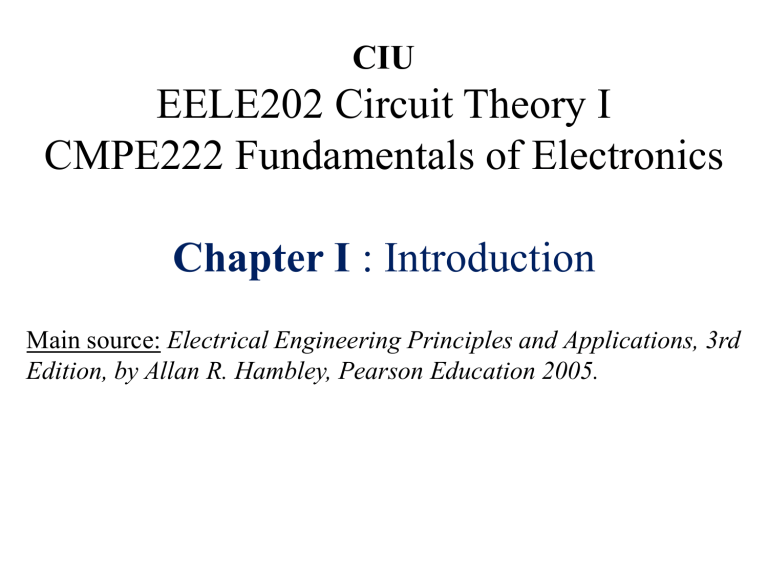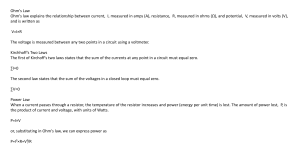
CIU EELE202 Circuit Theory I CMPE222 Fundamentals of Electronics Chapter I : Introduction Main source: Electrical Engineering Principles and Applications, 3rd Edition, by Allan R. Hambley, Pearson Education 2005. Before we start... These prefixes provide convenience in expressing values of quantities. Some will also be used throughout this course. The SI Prefixes Electrical systems have two main objectives: • To gather, store, process, transport, and present information • To distribute and convert energy between various forms Electrical circuit: Electrical Current Electrical current is the time rate of flow of electrical charge through a conductor or circuit element. The units are amperes (A), which are equivalent to coulombs per second (C/s). dq(t ) i (t ) = dt t q(t ) = i (t )dt + q(t0 ) t0 Direct Current /Alternating Current When a current is constant with time, we say that we have direct current, abbreviated as dc. On the other hand, a current that varies with time, reversing direction periodically, is called alternating current, abbreviated as ac. Electrical Voltage The voltage associated with a circuit element is the energy transferred per unit of charge that flows through the element. The units of voltage are volts (V), which are equivalent to joules per coulomb (J/C). A voltage which is constant with time is called dc voltage, whereas a voltage that varies with time, reversing direction periodically, is called ac voltage. examples: v1(t) = 10V (dc) v2(t) = 10cos(200πt) V (ac) Kirchoff’s Current Law (KCL) A node in an electrical circuit, is a point at which two or more circuit elements are joined. Kirchoff’s Current Law states that, • the sum of the currents entering a node equals the sum of the currents leaving a node or alternatively, • the sum of the currents entering a node is zero. Series circuits When elements are connected end to end, we say they are connected in series. Example: KCL at node 1 : ia = ib KCL at node 2 : ib = ic ➔ ia = ib = ic All elements in a series circuit have identical currents. Kirchoff’s Voltage Law (KVL) Kirchoff’s Voltage Law states that, • The algebraic sum of the voltages equals zero for any closed path (loop) in an electrical circuit. Parallel circuits We say that two circuit elements are connected in parallel, if both ends of an element are connected directly to the corresponding ends of the other element. Example: KVL for loop 1 (along A and B): -va + vb = 0 → va = vb KVL for loop 2 (along B and C): -vb - vc = 0 → vb = -vc ➔ va = vb = -vc The voltages across parallel elements are equal in magnitude and polarity. Example: Circuit Elements Conductors: The lines that connect the elements to each other. Independent sources: Circuit Elements (... cont.) Dependent (controlled) sources: Dependent (controlled) voltage sources: Dependent (controlled) current sources: Circuit Elements (... cont.) Resistors: The voltage v across an ideal resistor is proportional to the current i through the resistor. Unit of resistance (R) is Ohm (Ω). Ohm’s Law: v=iR Conductance (G) is the inverse (reciprocal) of resistance. Thus, Ohm’s Law can be rewritten as i=Gv Unit of conductance is inverse of Ohm (Ω-1), which is also called Siemens (S). Resistance and Resistivity The resistance of any material with a uniform cross-sectional area A and length l, depends on A , l and r, where r is the resistivity of the material. Some Resistor Types Power P=vi = i 2R = v 2/R (v=i R) (i=v/R) The unit of power is Watt (W). If P>0 ➔ Energy is being absorbed by the element. If P<0 ➔ The element is supplying energy to the other parts of the circuit. P = v i1 P = -v i2 Conservation of Energy: At a given instant, the sum of the powers of all elements in a circuit must be zero: for all elements Energy calculations where, p(t) is power, in Watts (W) w(t) is energy, in Joules (J) Note: An extra problem (with solution) will be provided separately (a more detailed problem, again related with energy calculation).






